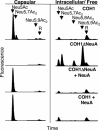Discovery and characterization of sialic acid O-acetylation in group B Streptococcus
- PMID: 15263085
- PMCID: PMC503750
- DOI: 10.1073/pnas.0403010101
Discovery and characterization of sialic acid O-acetylation in group B Streptococcus
Abstract
Group B Streptococcus (GBS) is the leading cause of human neonatal sepsis and meningitis. The GBS capsular polysaccharide is a major virulence factor and the active principle of vaccines in phase II trials. All GBS capsules have a terminal alpha 2-3-linked sialic acid [N-acetylneuraminic acid (Neu5Ac)], which interferes with complement-mediated killing. We show here that some of the Neu5Ac residues of the GBS type III capsule are O-acetylated at carbon position 7, 8, or 9, a major modification evidently missed in previous studies. Data are consistent with initial O-acetylation at position 7, and subsequent migration of the O-acetyl ester at positions 8 and 9. O-acetylation was also present on several other GBS serotypes (Ia, Ib, II, V, and VI). Deletion of the CMP-Neu5Ac synthase gene neuA by precise, in-frame allelic replacement gave intracellular accumulation of O-acetylated Neu5Ac, whereas overexpression markedly decreased O-acetylation. Given the known GBS Neu5Ac biosynthesis pathway, these data indicate that O-acetylation occurs on free Neu5Ac, competing with the CMP-Neu5Ac synthase. O-acetylation often generates immunogenic epitopes on bacterial capsular polysaccharides and can modulate human alternate pathway complement activation. Thus, our discovery has important implications for GBS pathogenicity, immunogenicity, and vaccine design.
Figures





References
-
- Moore, M. R., Schrag, S. J. & Schuchat, A. (2003) Lancet Infect. Dis. 3, 201–213. - PubMed
-
- Farley, M. M. (2001) Clin. Infect. Dis. 33, 556–561. - PubMed
-
- Campbell, J. R., Hillier, S. L., Krohn, M. A., Ferrieri, P., Zaleznik, D. F. & Baker, C. J. (2000) Obstet. Gynecol. 96, 498–503. - PubMed
-
- Nizet, V., Ferrieri, P. & Rubens, C. E. (2000) Streptococcal Infections: Clinical Aspects, Microbiology and Molecular Pathogenesis, eds. Stevens, D. L. & Kaplan, E. L. (Oxford Univ. Press, New York), pp. 180–221.
-
- Schrag, S. J., Zywicki, S., Farley, M. M., Reingold, A. L., Harrison, L. H., Lefkowitz, L. B., Hadler, J. L., Danila, R., Cieslak, P. R. & Schuchat, A. (2000) N. Engl. J. Med. 342, 15–20. - PubMed
Publication types
MeSH terms
Substances
Grants and funding
LinkOut - more resources
Full Text Sources
Other Literature Sources
Molecular Biology Databases

